You have an Azure subscription.
You plan to deploy a highly available SAP NetWeaver system to an Azure region that contains three availability zones. The system will be hosted in an Azure virtual machine scale set.
You need to recommend which type of deployment and which platformFaultDomainCount value to use. The solution must maximize the availability of the system.
What should you recommend? To answer, select the appropriate options in the answer area.
NOTE: Each correct selection is worth one point.

You plan to deploy an SAP production landscape on Azure.
You need to minimize latency between SAP HANA database servers and SAP NetWeaver servers.
What should you implement?
You have an Azure subscription that contains an SAP HANA on Azure (Large Instances) deployment. The deployment is forecasted to require an additional 256 GB of storage. What is the minimum amount of additional storage you can allocate?
You have an SAP Fiori single sign-on (SSO)-enabled subscription.
You have an Azure subscription that is linked to a Microsoft Entra tenant named contoso.com.
You need to configure SSO authentication between SAP Fiori and contoso.com.
Which five actions should you perform in sequence in the Microsoft Entra admin center? To answer, move the appropriate actions from the list of actions to the answer area and arrange them in the correct order.

You have an SAP production landscape in Azure. The landscape contains a two-node SAP HANA cluster that has HANA system replication configured.
Vou need to configure Azure Backup for the SAP databases. The solution must ensure that the databases will be backed up if a node fails over.
What should you do first?
Your on-premises network contains SAP and non-SAP applications. ABAP-based SAP systems are integrated with IDAP and use user name/password-based authentication for logon.
You plan to migrate the SAP applications to Azure.
For each of the following statements, select Yes if the statement is true. Otherwise, select No. NOTE: Each correct selection is worth one point.

Note: This question is part of a series of questions that present the same scenario. Each question in the series contains a unique solution that might meet the stated goals. Some question sets might have more than one correct solution, while others might not have a correct solution.
After you answer a question in this section, you will NOT be able to return to it. As a result, these questions will not appear in the review screen.
You have an SAP production landscape on-premises and an SAP development landscape on Azure.
You deploy a network virtual appliance to act as a firewall between the Azure subnets and the on-premises network.
You need to ensure that all traffic is routed through the network virtual appliance.
Solution: You create an Azure Traffic Manager profile.
Does this meet the goal?
You have an SAP HANA on Azure (Large Instances) deployment.
You need to generate hearth check log files for the Deployment.
What should you do?
You have an Azure subscription that contains two SAP HANA instances.
You plan to back up the instances by using Azure Backup.
You need to configure private endpoints and a name resolution solution to support the backups. The solution must meet the following requirements:
• Minimize the number of private endpoints required.
• Minimize administrative effort.
Which name resolution solution should you use, and what is the minimum number of private endpoints required? To answer, select the appropriate options in the answer area.
NOTE: Each correct selection is worth one point.
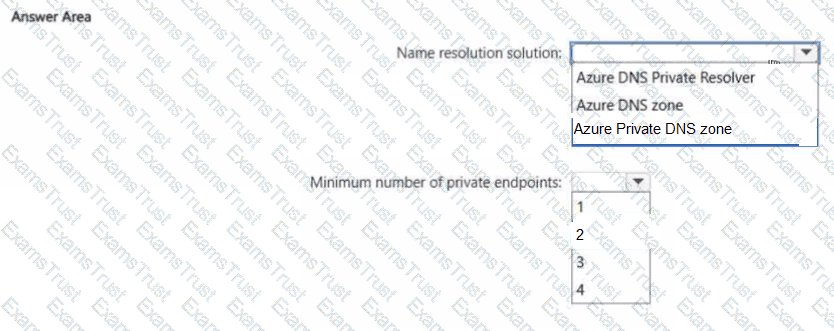
You have an SAP production landscape in Azure.
Users access the landscape from the internet by using Azure Application Gateway.
You need to analyze the network traffic of the landscape by using Azure Network Watcher traffic analytics.
What should you configure?
You are planning the Azure network infrastructure for an SAP environment.
For each of the following statements, select Yes if the statement is true. Otherwise, select No.
NOTE: Each correct selection is worth one point.
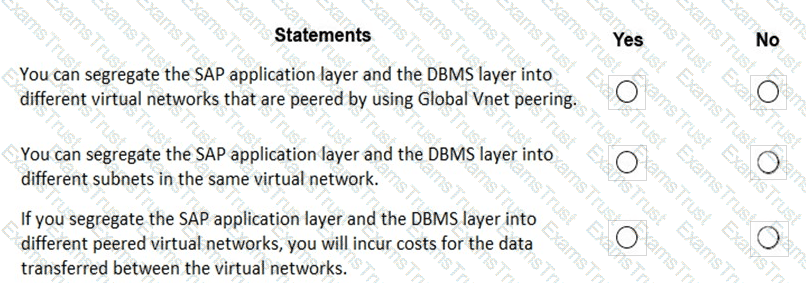
You have an existing SAP production landscape on Azure. The SAP application virtual machines have static IP addresses.
You need to replicate the virtual machines to another Azure region by using Azure Site Recovery. The source and target subnets have different address ranges.
Which three actions should you perform? Each correct answer presents part of the solution.
NOTE: Each correct selection is worth one point.
You plan to implement a deployment of SAP NetWeaver on Azure. The deployment will be hosted on virtual machines that run SUSE Linux Enterprise Server (SLES).
You need to identify which virtual machine size to use to meet the following requirements:
• The size must be based on the SAPS rating of the deployment.
• The virtual machines must be certified to run the deployment.
What should you use?
You have an Azure subscription that contains a virtual machine named VM1. VM1 runs SUSE Linux Enterprise Server (SLES) and hosts an SAP workload.
You deploy Azure Monitor for SAP solutions.
You need to configure the Linux OS provider. The solution must ensure that you can collect monitoring data by using the Prometheus endpoint on VM1.
Which firewall port should you open on VM1?
You have an SAP production landscape in Azure.
You need to recommend a disaster recovery solution that will enable failover between two Azure regions. The solution must provide the lowest recovery time objective (RTO) for a Microsoft SQL Server instance and SAP Central Services (SCS).
What should you include in the recommendation? To answer, drag the appropriate recommendations to the correct workloads. Each recommendation may be used once, more than once, or not at all. You may need to drag the split bar between panes or scroll to view content.
NOTE: Each correct selection is worth one point.

You are designing an SAP HANA deployment.
You estimate that the database will be 1.8 TB in three years.
You need to ensure that the deployment supports 60,000 IOPS. The solution must minimize costs and provide the lowest latency possible.
Which type of disk should you use?
You have an Azure subscription named Sub! that contains a Microsoft Sentinel workspace named Workspaces
You have an SAP RISE managed workload that is integrated with Sub1.
You plan to deploy the Microsoft Sentinel solution for SAP applications and use automated attack disruption in Microsoft Defender XDR.
You need to ensure that the SAP connector can access Workspace1 and the managed workload. The solution must follow the principle of least privilege.
Which roles should you assign to the managed workload and the connector for Workspace1? To answer, select the appropriate options in the answer area.
NOTE: Each correct selection is worth one point.

You plan to deploy SAP on Azure.
The deployment must meet the following requirements:
• Support failover to another Azure region in the event of a regional outage.
• Minimize data loss during a failover.
• Minimize costs.
Which fault tolerance technology should you choose for the SAP Web Dispatcher and the Microsoft SQL Server 2017 servers to meet the requirements? To answer, drag the appropriate technologies to The correct targets. Each technology may be used once, more than once, or not at all. You may need to drag the split bar between panes or scroll to view content.
NOTE: Each correct selection is worth one point.

You plan to deploy an SAP environment on Azure.
During a bandwidth assessment, you identify that connectivity between Azure and an on-premises datacenter
requires up to 5 Gbps.
You need to identify which connectivity method you must implement to meet the bandwidth requirement. The
solution must minimize costs.
Which connectivity method should you identify?
You have an SAP workload on an Azure virtual machine.
You have a built-in role-based access control (RBAC) role definition in the JSON format.
You plan to change the built-in role definition to a custom role definition.
Which property value in the built-in role definition must you change?
You have an SAP environment on Azure.
our on-promises network connects to Azure by using a site-to-site VPN connection.
6u need to alert technical support if the network bandwidth usage between the on-premises network and Azure exceeds 900 Mbps 10 minutes.
What should you use?
You plan to deploy an SAP RISE managed workload.
You need to recommend a security solution for the deployment. The solution must monitor for suspicious activity and automatically respond to the activity.
Which service should you include in the recommendation, and what should you use to ingest data into the service? To answer, select the appropriate options in the answer area.
NOTE: Each correct selection is worth one point.
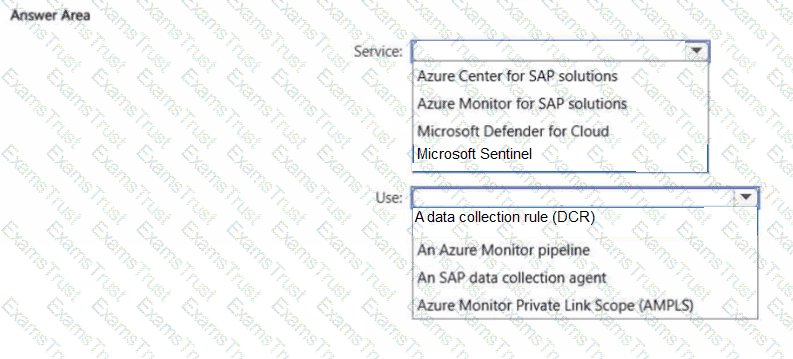
You plan to deploy two SAP NetWeaver landscapes named Production1 and Production2 to Azure. Production! will contain an SAP NetWeaver central services (ASCS/SCS) instance hosted on a Windows failover cluster. Production2 will contain an SAP ASCS/SCS instance hosted on a Linux Pacemaker cluster.
You need to recommend a shared storage solution for each landscape. The solutions must meet the following requirements:
• Minimize administrative effort.
• Minimize costs.
What should you include in the recommend? To answer, select the appropriate options in the answer area. NOTE: Each correct selection is worth one point.
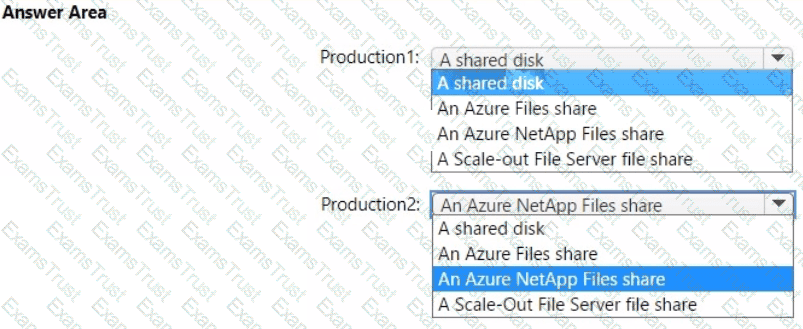
You have an SAP production landscape on Azure that contains the resources shown in the following table.

You need to stop the SAP services so that you can perform monthly maintenance.
Which command should you run from the Azure Cloud Shell? To answer, select the appropriate options in the answer area
NOTE: Each correct selection is worth one point.

You have an on-premises network and an Azure subscription.
You plan to deploy a standard three-tier SAP architecture to a new Azure virtual network.
You need to configure network isolation for the virtual network. The solution must meet the following requirements:
• Allow client access from the on-premises network to the presentation servers.
• Only allow the application servers to communicate with the database servers.
• Only allow the presentation servers to access the application servers.
• Block all other inbound traffic.
What is the minimum number of network security groups (NSGs) and subnets required? To answer, drag the appropriate number to the correct targets. Each number may be used once, more than once, or not at all. You may need to drag the split bar between panes or scroll to view content.
NOTE Each correct selection is worth one point.

You have an Azure subscription named Sub1 that is linked to a Microsoft Entra tenant named contoso.com. You have an on-premises deployment of SAP Landscape Management (LaMa).
You need to ensure that the on-premises LaMa deployment is authorized to manage the SAP resources provisioned to Sub1. What should you create first?
You have an SAP production landscape that uses SAP HANA databases on Azure.
You need to deploy a disaster recovery solution to the SAP HANA databases. The solution must meet the following requirements:
• Support failover between Azure regions.
• Minimize data loss in the event of a failover.
What should you deploy?
You have an SAP on Azure landscape that contains a virtual machine named VM1. VM1 hosts an SAP HANA database. You need to back up the database. The solution must meet the following requirements:
• Maintain six copies of each backup.
• Store the copies in two datacenters in the same geographical region.
• Minimize costs.
Which three actions should you perform in sequence? To answer, move all actions from the list of actions to the answer area and arrange them in the correct order.

You are designing a four-node SAP Web Dispatcher deployment for an SAP on Azure landscape.
You need to recommend a resiliency solution and a load-balancing solution for the deployment. The solution must meet the following requirements;
• Receive the highest SLA from Microsoft.
• Load balance client connections.
• Minimize administrative effort
What should include in the recommendation for each solution? To answer, select the appropriate options in the answer area. NOTE Each correct selection is worth one point.

Your on-premises network contains the following:
• A 1-Gbps internet connection
• An SAP HANA 1.0 instance that has a 4-TB database
• An SAP landscape that uses SUSE Linux Enterprise (SLES) 12
You have an Azure subscription that contains a virtual machine. The virtual machine is of the M64s SKU and runs SLES 15 and HANA 2.0.
You need to migrate the database to the virtual machine and upgrade the database to HANA 2.0. The solution must meet the following requirements:
• The migration must be performed during a weekend.
• The database can be offline during the migration.
Which migration method should you use?
You have a Hyper-V generation 2 virtual machine image that was prepared by running sysprep.exe. You plan to use the image as part of an SAP application server deployment on Azure. You need to ensure that you can deploy the image as an Azure virtual machine. What should you do first?
Before putting the SAP environment on Azure into production, which command should you run to ensure that the virtual machine disks meet the business requirements? To answer, select the appropriate options in the answer area.
NOTE: Each correct selection is worth one point.

Once the migrate completes, to which size should you set the ExpressRoute circuit to the New York office to meet the business goals and technical requirements?
This question requires that you evaluate the underlined BOLD text to determine if it is correct.
You are planning for the administration of resources in Azure.
To meet the technical requirements, you must first implement Active Directory Federation Services (AD FS).
Instructions: Review the underlined text. If it makes the statement correct, select “No change is needed”. If the statement is incorrect, select the answer choice that makes the statement correct.
Which Azure service should you deploy for the approval process to meet the technical requirements?
You are planning replication of the SAP HANA database for the disaster recovery environment in Azure.
For each of the following statements, select Yes if the statement is true. Otherwise, select No.
NOTE: Each correct selection is worth one point.
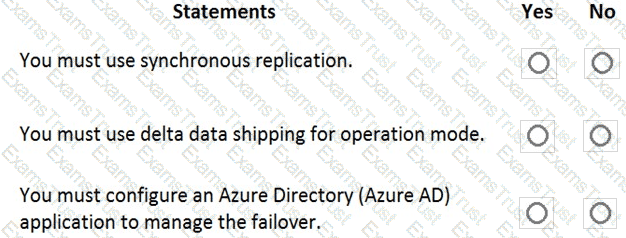
You need to provide the Azure administrator with the values to complete the Azure Resource Manager template.
Which values should you provide for diskCount, StorageAccountType, and domainName? To answer, select the appropriate options in the answer area.
NOTE: Each correct selection is worth one point.
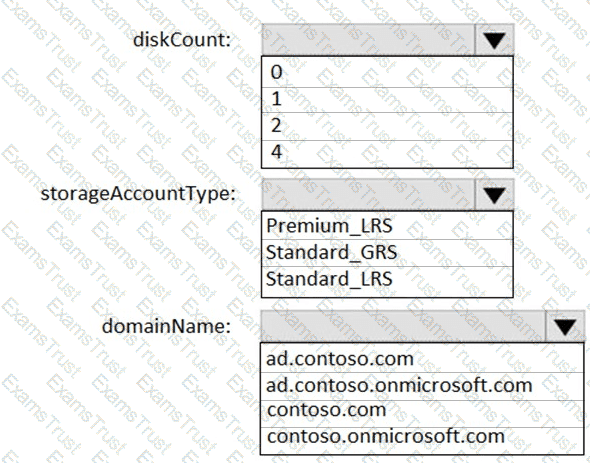
You are evaluating the proposed backup policy.
For each of the following statements, select Yes if the statement is true. otherwise, select No.
NOTE: Each correct selection is worth one point.
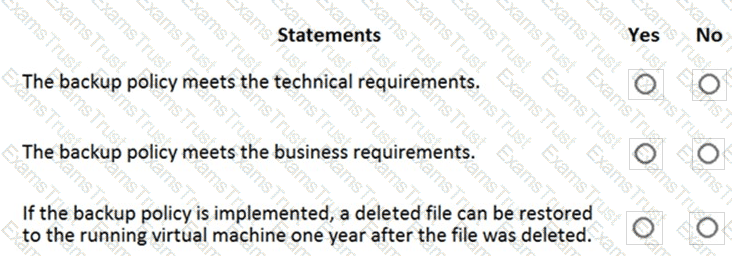
You are planning the Azure network infrastructure to support the disaster recovery requirements.
What is the minimum number of virtual networks required for the SAP deployed?
You are evaluating the migration plan.
Licensing for which SAP product can be affected by changing the size of the virtual machines?
For each of the following statements, select Yes if the statement is true. Otherwise, select No.
NOTE: Each correct selection is worth one point.

What should you use to perform load testing as part of the migration plan?
You need to recommend a solution to reduce the cost of the SAP non-production landscapes after the migration.
What should you include in the recommendation?
You need to ensure that you can receive technical support to meet the technical requirements.
What should you deploy to Azure?
For each of the following statements, select Yes if the statement is true. Otherwise, select No.
NOTE: Each correct selection is worth one point.

You are evaluating which migration method Litware can implement based on the current environment and the business goals.
Which migration method will cause the least amount of downtime?
Litware is evaluating whether to add high availability after the migration?
What should you recommend to meet the technical requirements?